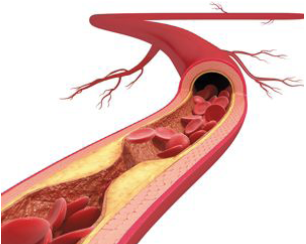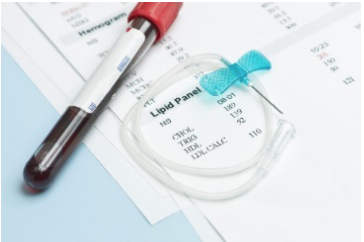Making Sense of Heart Disease Risk Factors
Introduction
Heart disease is sickness or poor functioning of the heart and its blood vessels. Cardiovascular disease is another term for heart disease. The heart is important because it pumps blood, which contains oxygen and nutrients to fuel cells throughout the body. The main form of heart disease is atherosclerosis, or narrowing and hardening of blood vessels. If the blood vessels in the heart become too narrow or are completely blocked, this can cause a heart attack.
Heart disease is the leading cause of death in the U.S. and throughout the world. Heart disease affects nearly everyone in some way. It is important to be aware of and track factors that can increase or decrease risk for this serious disease.

Source: Nature Reviews Cardi
What is a Risk Factor?
A risk factor is any characteristic or exposure that increases the chance of developing a disease. This means the presence of an exposure, such as smoking or poor diet, increases disease risk. Presence of an exposure does not mean the disease will definitely occur but it does mean the disease is more likely to occur.
Non-Modifiable Heart Disease Risk Factors
Non-modifiable risk factors are attributes that can alter the chance of a disease, but are outside of our control. We cannot change these factors; we can only keep them in mind when considering our overall disease risk.
- Age. A person’s age is a major risk factor for heart disease. As we age, our risk for heart disease increases, regardless of other risk factors.
- Sex. Men are at a more increased risk for heart disease compared to women. However, later in life (60’s and beyond), the difference in heart disease risk between sexes disappears.
- Ethnicity. Certain ethnicities or races including African American, Hispanic and Native American are at increased risk for heart disease.
- Family history. Genetics play a role in heart disease risk. Let your doctor know if you have close relatives who have or had heart disease, especially if it occurred at a young age.
Modifiable Heart Disease Risk Factors
Modifiable risk factors are factors we can control that alter disease risk. Since we can change these factors by what we do, they are very important to consider and track.
Lifestyle Behaviors
- Physical activity. Regular physical activity helps lower heart disease risk. The opposite is also true – being inactive increases risk. Adults should do at least 150 minutes a week of physical activity. Adults should also do strengthening (such as lifting weights) and stretching activities at least two days a week. In addition, sedentary behavior, or sitting for long periods, can increase heart disease risk even if we exercise regularly. Most of us need to move more and sit less to lower heart disease risk.
- Diet. It is no secret that what we eat affects our health, including our heart health. To lower heart disease risk, aim to eat a diet rich in nutrients and low in calories. Fruits, vegetables, whole grains, nuts, beans, peas, lentils, seafood, low-fat dairy and lean meats are “nutrient-dense” foods. Nutrient-dense foods provide a lot of nutrients and little calories. On the other hand, fried foods, sweets and fast foods are “energy-dense” foods. Energy-dense foods provide a lot of calories and little nutrients and should be limited in the diet.
- Smoking. Tobacco use is a major risk factor for heart disease. Avoiding or stopping tobacco use are major risk-lowering lifestyle approaches.
- Stress. Long-term and extreme stress increases heart disease risk. This is likely due to behaviors we perform when stressed (such as over-eating and inactivity) and physical changes (increased stress hormones, inflammation, blood pressure and cholesterol).
Source: Harvard Health Publishing
Physical Markers
-
Blood pressure. Blood pressure is the pressure of the blood on the blood vessel walls. A blood pressure reading consists of two numbers, for example 135/95. The first number (systolic pressure) is the pressure when the heart beats. The second number (diastolic pressure) is the pressure when the heart relaxes.
Table 1.
| Blood Pressure Categories | Systolic Blood Pressure | Diastolic Blood Pressure |
|---|---|---|
| Optimal | <120 mmHg | <80 mmHg |
| Elevated | 120-129 mmHg | <80 mmHg |
| High Blood Pressure (Hypertension) Stage 1 | 130-139 mmHg | 80-89 mmHg |
| High Blood Pressure (Hypertension) Stage 2 | ≥140 mmHg | >90 mmHg |
High blood pressure, or hypertension, means the heart has to work harder to pump blood into the vessels. Overtime, this can overwork the heart, leading to heart disease. In addition, high blood pressure can damage the blood vessels. High blood pressure is a “silent killer” because people can have high blood pressure and not know it.
- Total cholesterol. Cholesterol is a type of fat in all human body cells and in foods from animal sources, such as meat, eggs, and dairy products. The body needs cholesterol. However, the body can make the cholesterol it needs so you do not need to have it in your diet.
Table 2. Total Cholesterol Categories.
| Optimal | <200 mg/dL |
|---|---|
| Borderline High | 200-239 mg/dL |
| High | ≥240 mg/dL |
When cholesterol is high, it can build up in the blood vessel walls, restricting blood flow and oxygen delivery. If this build up occurs in vessels of the heart, it can lead to a heart attack. Fats in the blood travel in transport compounds called lipoproteins (such as HDL, LDL and VLDL). Total cholesterol includes all of the cholesterol in blood lipoproteins.
- LDL-cholesterol. LDL stands for low-density lipoprotein. LDL or “bad cholesterol” is the main lipoprotein that promotes cholesterol storage in the blood vessel walls.
Table 3. LDL-cholesterol Categories.
| Optimal | <100 mg/dL |
|---|---|
| Near Optimal | 100-129 mg/dL |
| Borderline High | 130-159 mg/dL |
| High | 160-189 mg/dL |
| Very High | ≥190 mg/dL |
High LDL can mean cholesterol is being stored in the blood vessel walls. Cholesterol storage in blood vessel walls is a major part of plaque build-up, which impairs how the blood vessels function and can lead to a heart attack or stroke if blood flow is limited or blocked.
- HDL-cholesterol. HDL stands for high-density lipoprotein. HDL or “good cholesterol” removes cholesterol stored in the blood vessels walls and takes the cholesterol to the liver for removal.
Table 4. HDL-cholesterol Categories.
| Low | <40 mg/dL |
|---|---|
| Moderate | 40-60 mg/dL |
| High/Optimal | >60 mg/dL |
Low HDL means a decreased ability to remove cholesterol from blood vessel walls. Therefore, people with low HDL are at higher risk for heart attack and stroke.
- Triglycerides. Triglycerides are another type of fat. Triglycerides are the most common type of fat found in food, body fat stores and the blood. When a person eats a meal high in fat, triglycerides in the blood increase for several hours.
Table 5. Triglyceride Categories.
| Optimal | <150 mg/dL |
|---|---|
| Borderline High | 150-199 mg/dL |
| High | ≥200 mg/dL |
High triglycerides are a risk factor for heart disease and type 2 diabetes. Like cholesterol, high triglycerides can cause plaque buildup in the blood vessels, which can lead to heart attack or stroke.
- BMI. BMI stands for body mass index. BMI is a simple tool for assessing a person’s weight in terms of their height. BMI is a person’s weight (in kilograms) divided by their height (in meters) squared. However, BMI does not distinguish the amount of a person’s weight that is fat versus lean tissue, like muscle.
Table 6. BMI Categories.
| Underweight | <18.5 kg/m2 |
|---|---|
| Healthy Weight | 18.5-24.9 kg/m2 |
| Overweight | 25.0-29.9 kg/m2 |
| Obese | ≥30.0 kg/m2 |
While BMI is not a perfect guide, people with a BMI outside of the healthy range, especially underweight and severely obese, tend to be at an increased risk for heart disease.
How is Oklahoma Doing?
The following data are from the Oklahoma Department of Health’s 2017 State of the State’s Health Report. These data demonstrate that we are failing as a state to address these critical concerns.
- Physical Activity. Among Oklahoma adults, 32 percent did not do any exercise. The national rate is 26 percent. Grade: F
- Fruit and Vegetable Consumption. Among Oklahoma adults, 46 percent ate less than one fruit serving a day and 17 percent at less than one vegetable serving a day. Grade: F/C
- Smoking. Among Oklahoma adults, 20 percent were current smokers. The national average was 17 percent. Grade: D
- High Blood Pressure. Among Oklahoma adults, 38 percent had high blood pressure. The national rate is 32 percent. Grade: D
- High Cholesterol. Among Oklahoma adults, 37 percent had high cholesterol. The national rate is 33 percent. Grade: D
- Heart Disease Deaths. Heart disease deaths were 237 per 100,000 people in Oklahoma in 2017. The national average was 165 per 100,000 people. Grade: F
- Death Rate. The 2017 overall death rate in Oklahoma was 902 per 100,000 people. The national rate was 732 per 100,000 people. Grade: F
Putting It All Together: What Can You Do About It?
As you can see, heart disease is a common health problem affecting many people throughout Oklahoma and beyond, and there are several risk factors for heart disease. The good news is that you can improve most of your heart disease risk factors by following these simple strategies:
- Be physically active
- Exercise regularly
- Avoid sitting too much
- Consume a healthy diet
- Limit your portion sizes and overall calories
- Consume more fruits and vegetables
- Consume more whole grains
- Limit foods high in saturated fat, sodium and added sugars
- Limit processed foods
- Do not smoke or use any other tobacco products
Monitor your risk as you age by tracking your values over time. Use the table below to track your risk factor values for a five-year period. Your primary care physician can easily measure and provide these values each year for you. Your place of work may also provide these values through yearly health screenings. Or you may periodically check these values at health screenings at local grocery stores or pharmacies.
Summary
Heart disease is a serious public health problem affecting many people in Oklahoma,
the U.S. and the world. Fortunately, with guidance from healthcare professionals,
you can make changes to avoid heart disease before it develops. Some risk factors
are not controllable, such as age and family history. However, people can improve
many factors such as increased physical activity and improved dietary habits. People
should consult with their doctor and consider making necessary lifestyle changes to
lower their risk.
If you are interested in educational programs to help reduce your heart disease risks,
please contact your local county Extension office.
Additional Resources
Weight Maintenance Guidance from the National Institutes of Health
https://www.nhlbi.nih.gov/health/educational/lose_wt/recommen.htm
2015-2020 Dietary Guidelines for Americans
https://health.gov/our-work/food-nutrition/2015-2020-dietary-guidelines/guidelines/
Physical Activity Recommendations from the American Heart Association
https://www.heart.org/en/healthy-living/fitness/fitness-basics/aha-recs-for-physical-activity-in-adults
Additional Information on Risk Factor Biomarkers from the American Heart Association
https://www.heart.org/en/health-topics


